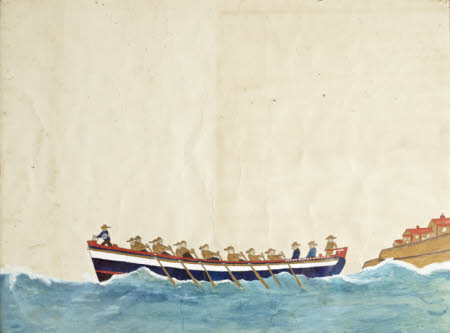The Lifeboat 'Henry Ramey Upcher' (1894 - 1935) at Sheringham
British (English) School
Category
Art / Oil paintings
Date
1894 - 1935
Materials
Oil on paper
Measurements
367 x 493 mm
Place of origin
Sheringham
Order this imageCollection
Felbrigg, Norfolk
NT 801521.1
Summary
Oil painting on paper, The Lifeboat 'Henry Ramey Upcher' (1894 - 1935) at Sheringham. The Henry Ramey Upcher was the gift of Mrs Caroline Upcher of Sheringham Hall, donated to the fishermen in memory of her husband. She was built by Lewis 'Buffalo' Emery of Sheringham, for £150, in the style of the local crab fishing boats; using local oak for the planking and fastened throughout with copper. She measured 39'9" long x 11'3" wide, was double ended, carried 16 oars and was fitted with a large dipping lug-mainsail and a mizzen. She was named by Mrs Upcher on 4th Sept 1894 and remained in service until 1935. She worked closely with the RNLI station boats 'William Bennett' and 'J.C. Madge', and was very popular with the fishermen as she was lighter than the RNLI boats and could be launched faster, (although her width tended to make her more liable to ship water in severe conditions so was less suitable than the RNLI boats in heavy seas). The Henry Ramey Upcher launched over 50 times and saved over 200 lives. A full crew was generally 28 men: coxwain, deputy coxwain, 16 oarsmen, 8 men to tend the sails and 2 more men to work the pumps near the stern. One of the most famous of The Henry Ramey Upcher's rescues was to the Ispolen on 23rd Jan 1897. A strong North Easterly gale with snow had been blowing for 48 hours along the North Sea coasts raising heavy seas. The 236 ton wooden brig was enroute from Norway to Gravesend laden with ice. Two days after setting off on the 19th January she encountered very rough weather, shipping so much water that her pumps had to be kept going. By the 23rd she had sprung a leak and, with the wind dead on shore, was unable to prevent herself being driven towards the coast. Inscription 'Presented to Mrs Upcher of Sheringham Hall by the fishermen of Sheringham in memory of 55 years successful service of the lifeboat Augusta and in token of their gratitude for the gift of the new lifeboat Henry Ramey Upcher launched 4th Sept 1894'
Provenance
Given to the National Trust in 1980
Marks and inscriptions
This picture to be given to the National Trust Sheringham, Hall
Makers and roles
British (English) School, artist

